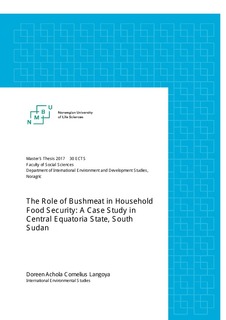| dc.description.abstract | The study was done to understand the role of bushmeat for households’ food security in the Central Equatoria State of South Sudan. A sample of 100 households were interviewed using a quantitative survey method, to assess the amount of their monthly consumption of bushmeat, frequency of consumption, income generated from bushmeat sale and challenges faced in using bushmeat as a food resource. The collected data were analyzed using SPSS software version 20.
The result showed that the most eaten bushmeat was wild mammals, followed by birds and insects. The majority of respondents did not consume reptiles, but a low rate of consumption of crocodile and python was documented. In terms of the type of bushmeat hunted, the most hunted bushmeat species were antelopes: Bohor reedbuck (Redunca redunca), Mongalla gazelle (Gazella rufifrons albonotata) and warthog (Phacochoerus africanus), followed by rodents (rats, porcupines and hares). Few hunted Hippopotamus (Hippopotamus amphibious) and a respondent who hunts more than two types of mammals mentioned reticulated giraffe (Giraffa Camelopardalis).
The amount of bushmeat consumed /kg/ month was significantly higher when compared with livestock’s meat ( Cattle’s meat, goat’s meat and sheep’s meat).When compared with other food types, although it was lower than the amount of cereals and green vegetables consumed, still the quantity of bushmeat consumed was higher than the quantity of chicken and fish. Regarding the frequency of hunting between and within seasons, hunting for bushmeat was generally done seasonally and especially during the dry season. Concerning the contribution of bushmeat to households’ income, on average bushmeat generated significantly higher income per month compared to other sources of income like charcoal making, firewood collection and salaries of the unclassified staffs (Unprofessional Staffs). The majority of respondents used the money generated from sales of bushmeat for buying additional food, and for paying children’s school fees. Regarding the challenges for using bushmeat as a food resource, the challenges included insecurity, wildlife laws, lack of men in the family and harmful animals. 42.58% of the interviewees reported insecurity as the most challenging threat to hunting. It generally shows that bushmeat is very important for the food security and income of the households studied. | nb_NO |

